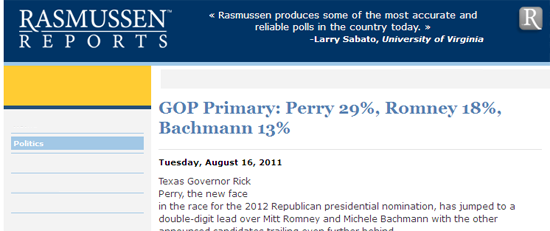This week, candidate Rick Perry continued his strong advance in US national polling. The August 26, 2011 Wall Street Journal Political Diary, under the article of Perry on Top, reported these two polling results:
Gallup: "According to Gallup, Mr. Perry now leads the Republican presidential field with 29% of the vote. Mitt Romney, who was ahead up to this point, has fallen to 17% (he was at 23% in July and 27% in June), while Michele Bachmann has fallen to fourth place with just 10%. Ron Paul, meanwhile, took 13%."
PPP: "They put Mr. Perry at 33%, Mr. Romney at 20%, and Ms. Bachmann at 16%. All other candidates were in single digits."
These polling results correlate well with our 2012 News Pattern Radar that has been tracking candidate Perry among competitors and issues over many months and hundreds of thousands of news/blog articles. This News Radar snapshot tracks the Perry news topic as it danced around the radar periphery for many weeks while Romney led in the polls. Then around the middle of August at the Perry official announcement, the Perry topic vectored into the radar center, as a news pattern that indicated that Perry became more relevant than Romney and the entire 2012 GOP field.

All during this period from June 1st, until August 26, 2011, the core 2012 news patterns of Conservative and Obama were quite consistent, indicating that the 2012 election is emerging as conservative ideas versus Obama. Also consistent were the high relevancies of Economy, Jobs and Spending topics, all highly connected to the Obama topic and the core of the 2012 radar.
If the Romney topic is to displace the Perry topic, and correspondingly regain leadership in the polls, Romney news patterns will need to better connect with Obama and the core topics, as a replacement for the Perry news topic.
See real-time version of 2012 radar at ... http://www.newspatterns.com/show_radar.php?name=gop2012


